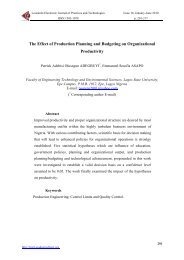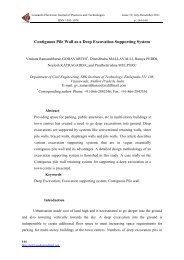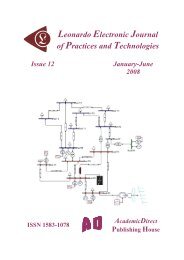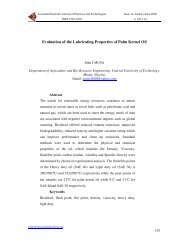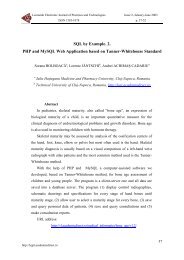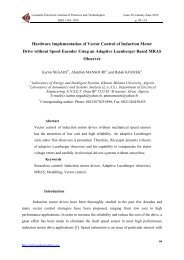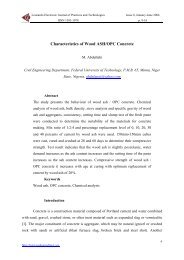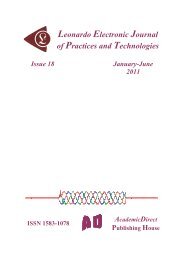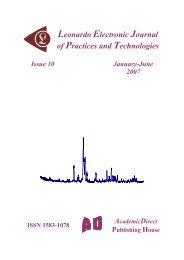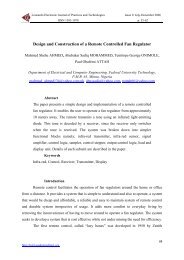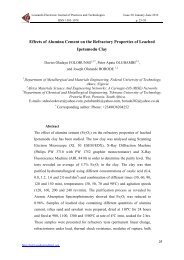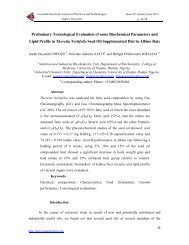p. 106-121 - Leonardo Electronic Journal of Practices and ...
p. 106-121 - Leonardo Electronic Journal of Practices and ...
p. 106-121 - Leonardo Electronic Journal of Practices and ...
You also want an ePaper? Increase the reach of your titles
YUMPU automatically turns print PDFs into web optimized ePapers that Google loves.
<strong>Leonardo</strong> <strong>Electronic</strong> <strong>Journal</strong> <strong>of</strong> <strong>Practices</strong> <strong>and</strong> Technologies<br />
ISSN 1583-1078<br />
Issue 13, July-December 2008<br />
p. <strong>106</strong>-<strong>121</strong><br />
The amount <strong>of</strong> flux-ammonium chloride-dispersed in a fixed quantity <strong>of</strong> intermetallic<br />
dross was determined through wet analysis. The analysis involve identification <strong>of</strong> both<br />
ammonium <strong>and</strong> chloride ions to confirm the presence <strong>of</strong> flux in the dross <strong>and</strong> then using<br />
simple stoichiometry equation to determine amount <strong>of</strong> flux dispersed in a known quantity <strong>of</strong><br />
dross.<br />
Identification <strong>of</strong> Ammonium, Chloride Ions <strong>and</strong> Calculation <strong>of</strong> Amount <strong>of</strong><br />
Flux in Dross<br />
1g <strong>of</strong> the dross sample was placed in 25ml beaker. 2ml 6M sodium hydroxide solution<br />
was added. The mixture was covered with a watch glass stucked with a piece <strong>of</strong> red litmus<br />
paper underneath it. The content was warmed gently. The red colour <strong>of</strong> the litmus paper<br />
changed to blue, thus confirming the presence <strong>of</strong> ammonium ions.<br />
2g <strong>of</strong> dross sample was weighed <strong>and</strong> placed in 25ml beaker. 10ml saturated solution <strong>of</strong><br />
sodium carbonate was added <strong>and</strong> warmed until the sample dissolved. 3 drops <strong>of</strong> the warmed<br />
solution was added to 10ml <strong>of</strong> water <strong>and</strong> acidified with nitric acid. 2ml <strong>of</strong> 0.1M silver nitrate<br />
solution was added. A white precipitate <strong>of</strong> silver chloride formed immediately. This confirms<br />
the presence <strong>of</strong> chloride ions.<br />
AgNO + Cl ⎯⎯→<br />
AgCl<br />
+ NO<br />
−<br />
−<br />
3 ( S ) 3 ( aq)<br />
1g <strong>of</strong> dross sample was dissolved in 6M sodium hydroxide in a 100ml beaker. The mixture<br />
was agitated <strong>and</strong> allowed to settle. Ammonia gas was evolved. The volume <strong>of</strong> hydrochloric<br />
acid produced was determined through titration with sodium hydroxide. The titre value <strong>of</strong> Hcl<br />
was 59.9ml. Therefore, the volume <strong>of</strong> sodium hydroxide consumed by ammonium chloride to<br />
liberate ammonia (NH3) gas is (60-59.9) ml = 0.1ml<br />
Results <strong>and</strong> Analysis <strong>of</strong> Result<br />
Analysis <strong>of</strong> Result<br />
The stoichiometry equation for the reaction is<br />
NaOH +<br />
+ NH 4Cl ⎯⎯→<br />
NH 3 + HCl<br />
( g ) ( aq)<br />
H 2O<br />
↑<br />
( L)<br />
1 mole NH4CL requires 1 mole NaOH to liberate 1 mole NH3(g).<br />
112



